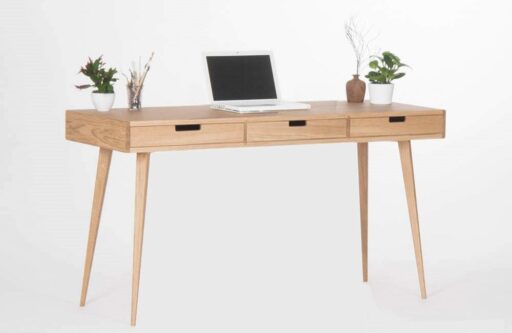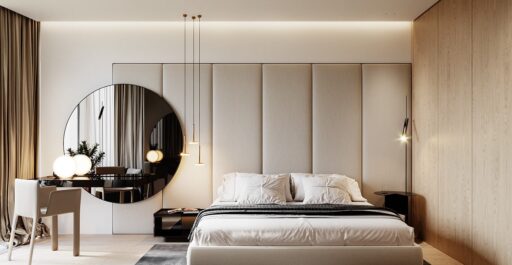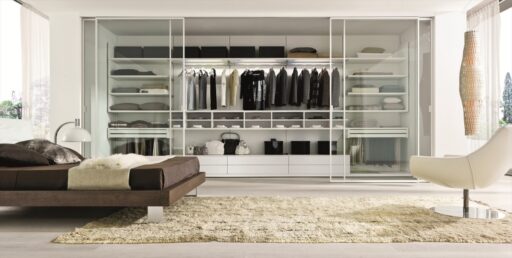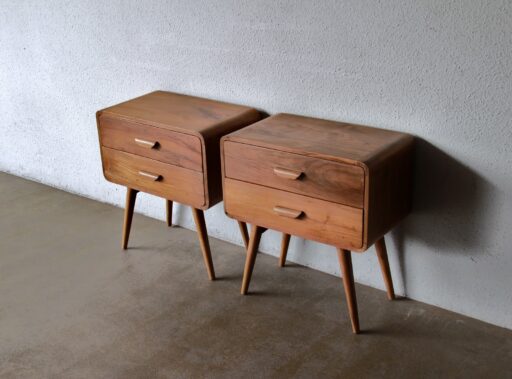Children’s room
The environment that accompanies growth
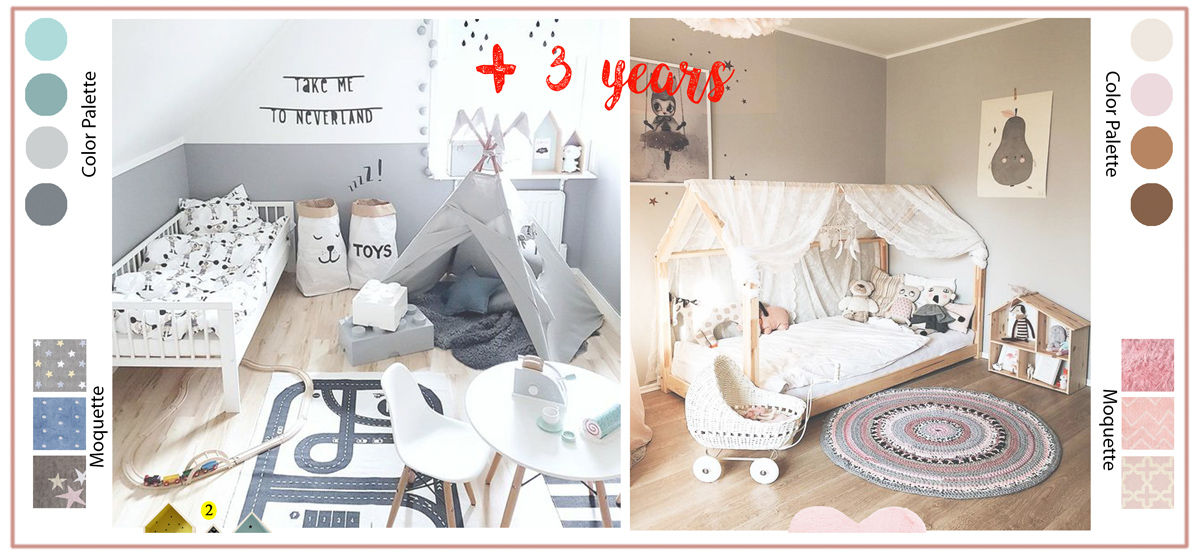
1. When good planning determines the right growth of the child
When dealing with the client, it is important to study in depth what are the needs of the individual, trying to satisfy them, taking into account the contingent limits such as the budget available and the spatial characteristics that are available. The ultimate goal is to make the people who will inhabit the spaces happy, and if those people have children or teenagers the task is even more difficult.
The bedroom design is very important because it is a space where the child will grow up, where they will meet to play and study; the environment that will accompany the boy over time during the phases of his life. It is therefore of fundamental importance to take into account some characteristics with a particular focus on the social and psychological point of view.
The first factor that will determine the physical conformation of the space and that will influence the design choices is the rapid change in the age of the user and consequently in personal tastes. Today on the market it is possible to find furnishing solutions that can evolve over time according to the needs of the newborn who will become a boy over time. It is a choice that can overcome the problem of progressive change but which risks not coinciding with the taste of the child who will be increasingly demanding over the years.
It is therefore necessary to make an initial choice, based on the budget available and on the flexibility of the environment. It is important to point out that on the market there is a wide choice of solutions that satisfy all needs even at low cost and that allows you to replace even just part of the furniture according to the needs of the moment.
In the event that you want to contain expenses, the optimal solution is to opt for neutral and long-term exploitable furniture customized by accessories suitable for specific ages. If, on the other hand, the budget allows it, you can indulge yourself with more particular lines that emulate soft shapes of clouds and flowers for babies and cartoon characters for school-age children. Then there are the wall decorations, very effective for the child’s interaction and easy to apply and remove if necessary.
Fairy-tale illustrations are perfect for babies, comics are suitable for children, while skylines of famous cities and graffiti go well with the taste of teenagers. As needs change over time, it is important to think long term. For this purpose, wall stickers and washable paints are perfect. In fact, both allow to affix and remove decorations with great ease. In any case, the main objective is to find the right balance between functionality and aesthetics, guaranteeing the best daily liveability
2. Safety and mobility in spaces
The study of spatial conformation is the basis of any renovation or ex novo project. In the event that the space is small, it is necessary to study very well the most functional solution that makes the most of the environment. As for the child’s bedroom, it is important to divide it into real areas dedicated to specific purposes; in neonatal age it will be necessary a space for the change, one for the baby food and one for the sleep. As the child grows up and begins to interact, new needs will arise, such as playing and subsequently carrying out schoolwork.
The subdivision of the space also helps the correct education of the child who will thus learn to have well marked the hours of the day and to define personal habits.
He will understand that there is a schedule for duties and one for rewards and will learn to move in the functional environment for every need. Security is also a fundamental prerogative of the environments we live in, even more so if they are experienced by children, who are much more vulnerable. The first step is therefore to study and predict as much as possible the movements and paths that the child will be able to make over time.
The walkways and trajectories must be safe, free from protrusions or elements that are dangerous to children; useful for this purpose are the corner protectors which, affixed to furniture and accessories, prevent injuries in the event of any accidental impacts. In addition, in the early stages of life, when the child learns to crawl and then to walk, the presence of shockproof mats and floor areas can help to feel more comfortable. These are simple solutions to affix to the ground that require undemanding maintenance and cleaning and that can be removed when they are no longer considered necessary. In the bedrooms it is necessary to pay particular attention since the floor should not be considered only a surface on which to walk, but a space to live, where to sit, play and take the first steps.
The characteristics of solidity, comfort, thermo-acoustic insulation and safety are therefore the basis for correct choices and efficient performance.
Another element to consider even before choosing furniture and objects is the material of the same which must be non-toxic and natural in order to respect the health of children. The paints that will cover the wall surfaces must be water-based, while the furnishings must be free of chemical glues and materials of non-certified origin. Last but not least to consider is the aesthetic performance which in these cases plays an important role; in addition to blending harmoniously with the rest of the house, the finishes chosen specifically must be warm and welcoming and arouse the interest of the little user, perhaps through fairytale motifs (in the case of carpet and anti-shock inserts) or thanks to the insertion of textile accessories that are soft and colorful.
The fundamental objective is therefore to optimize the space and make it safe and functional. In the event that we are faced with a small environment it is important to seek solutions that allow you to have everything you need and at the same time to move comfortably and without obstacles. There are many proposals on the market that help those who are faced with the spatial constraint; for example, you can choose between bridge bedrooms, loft beds or retractable beds and sliding desks and space-saving containers. These furnishings, in addition to gaining free space to play, stimulate the creativity of the little ones. A useful and aesthetically pleasing idea is characterized by the rigid poufs that perform the dual function of seat and support surface. With the passage of time it has become increasingly easier to find flexible, modular but also pleasing to the eye solutions thanks to the studied details and heterogeneous materials capable of satisfying the most demanding tastes. What apparently may seem like a constraint, thus becomes an interesting starting point to train the imagination and creativity of young and old.
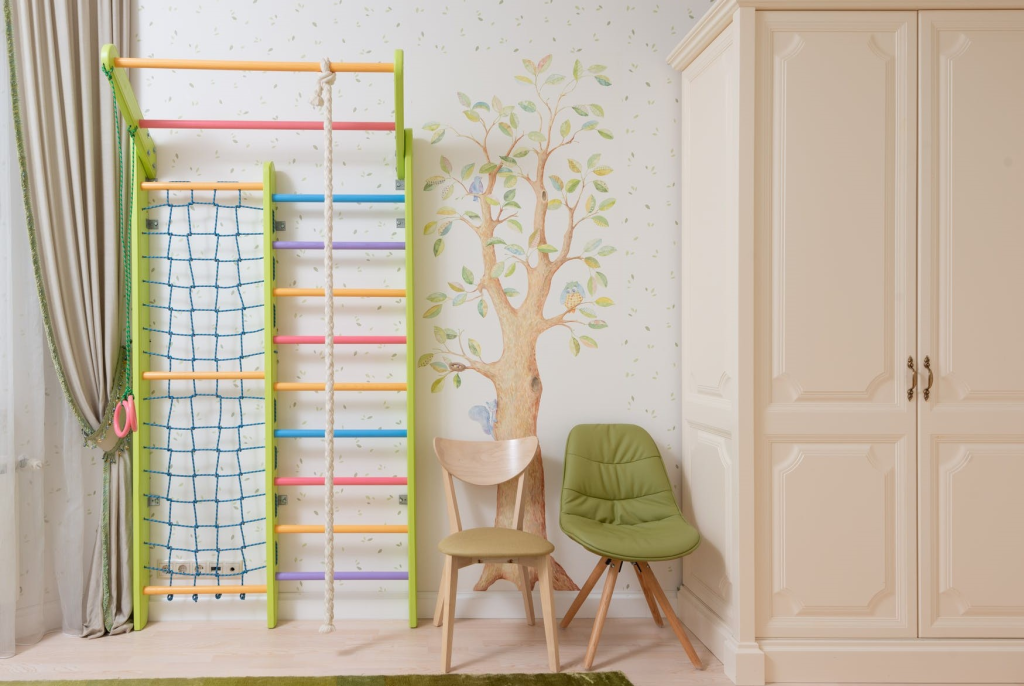
Archipel is a series of modular furniture aimed at saving space and creating real game islands. The composition of the modules is simple and takes place through bands fixed with velcro.
3. The psychology that guides the design process. Color and psychophysical well-being
If you have heard of “chromotherapy” at least once, you will know that it is a branch of natural medicine designed to study the effect of color on the mood of man. In fact, it is well known how much the environment can contribute to the well-being or, on the contrary, to the disturbance of those who live it; science argues that color with its variable wavelengths influences the mood and mood of the observer.
This premise serves to introduce the theme of color applied to environments and the importance of color choices in the design phase. If it is the children’s room, then the attention increases because a good design can guarantee the comfort of the child who will grow up in that space dividing between playful and educational activities.
As for the walls, they will play a fundamental role in the mood of those who spend a lot of time in the bedroom; the ultimate goal is to ensure cheerfulness and liveliness but at the same time sound sleep. Below is a brief overview of colors that can help you make informed and informed choices.
BLUE synonymous with relaxation and tranquility, it keeps your heart rate and blood pressure regular. It helps to dissolve tensions and is particularly suitable for the newborn even in its pastel shades.
PINK for those who love tradition, it is the most used color in the case of daughters. Romantic, it helps sleep and evokes the world of fairies. For this reason it is particularly suitable for childhood, less so for adolescence.
YELLOW paired with orange, it refers to the warm colors of the sun. As it promotes concentration and stimulates creativity, it is perfect for teen rooms. It is often chosen with green as an additional color to neutral tones to enliven them. If it is a smaller child’s room it is better to choose them in pastel shades.
GREEN the color reminiscent of nature, adapts very well to environments intended for adolescents as it promotes open-mindedness and optimism. According to recent studies, this color contributes to the formation of personal character, facilitating its balance, self-esteem and good mood.
The tones of PURPLE, BLACK, BROWN AND ANTHRACITE are not the best choice for the bedroom because they are too dark and not very stimulating during childhood.
If you want to be a little more daring, you can also mix several chromatic shades in order to create a more original environment. The choice of combining a warm color with a colder one may seem risky and not optimal, but if you opt for a bright and pastel tone the result will be unexpected. In any case, asking the child’s opinion can be useful to satisfy not only your taste but also that of your children.
Furthermore, in case you choose a brighter tone, it is recommended to place it on a single wall or create an insert, thus leaving white or more subdued walls, space for drawings, frames, photos and shelves. This is also to avoid getting tired in a short time of a color that in any case is more demanding. When choosing the tones for the environment that we want to set up or renovate, it is essential to take into account how the colors are useful for dressing the room and changing its characteristics on a visual level. The warm shades tend to compress the space while the cold ones widen it; for example, if the room is small in size, a single cold tone will be perfect, avoiding the multicolored choice.
In this regard, the white color is the most suitable for creating greater depth and optically enlarging the spaces; if the choice falls on white, you can give free rein to the imagination as regards complements and accessories that will stand out with harmony in the neutral whole.
4. Needs that change over time: bedrooms that grow with the child
As previously mentioned, when you have to furnish the room of a new unborn child, you find yourself faced with a choice: to renew the environment over time, adapting it to the growth of the child or to choose neutral furnishings that transform over the years? Of course, the choice also depends on the budget you have available.
Today on the market there are many solutions designed to change with the needs: made up of modules that can be added or subtracted, they adapt to the physicality and growth of the child. Height-adjustable desks, high chairs that with a gesture become tables, the rocking horse that transforms into a simple chair and the cradle that becomes a bed and then a sofa. Some companies offer wardrobes made up of modules that can be added progressively, becoming real wardrobes for teenagers.
Other brands, on the other hand, have preferred to create real kits necessary for the transformation of the furniture rather than standardized modules. In any case, the concept of an environment in continuous evolution, flexible and suitable for different needs, is at the base, which is therefore modeled on the needs of children. Here are some interesting examples of how furniture can live different lives satisfying the needs of the passing of time.

The Dot and Cross brand offers a series of design furniture intended for children but ready to change with their needs. An example is the flexible bed that can become a comfortable sofa useful as the child grows.
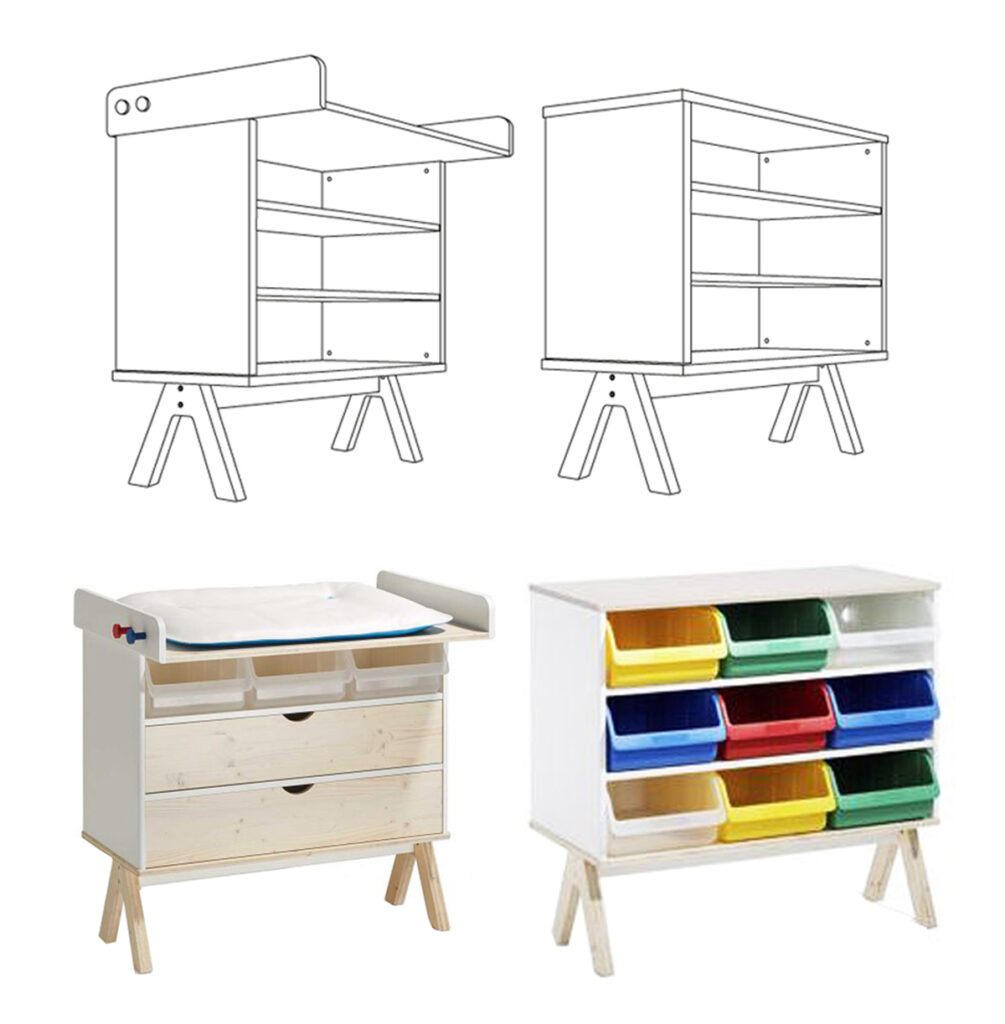
The designer Richard Lampert has created this comfortable, versatile and modular chest of drawers with drawers of different sizes and materials.
This is how from a changing table with an essential design, it becomes a colorful chest of drawers ready to house toys and accessories.
Source: www.richard-lampert.de
5. When the needs are particular: shared bedrooms
In the event that the environment must be shared by several brothers, perhaps of different sexes or ages, the designer will be faced with a more difficult task: to find the right solution considering the differences and make them a plus value. In fact, even if more complicated, the organization of the interior space in this case must be a challenge that overcomes the apparent constraints.
In case the children are a boy and a girl, there are different characters to be analyzed, first of all the choice of the colors of the walls. Neutral shades of beige, white and gray are to be preferred, which can then be combined with the more lively colors of the complements of one or the other. If, on the other hand, you love warmer and brighter tones, opt for yellow and orange, unisex, they will be perfect for both. From the furnishing point of view, however, the one with clean lines is perfect, devoid of references to the world of fairy tales or with bizarre shapes.
And if it comes to space-saving furniture, even better! In shared rooms, they allow you to gain centimeters so that children can play more comfortably, ensure greater order and are multifunctional. As for the actual layout of the room, it is important to delimit the spaces, in order to avoid the typical quarrels between brothers. A useful and also nice method is to hang or place the initials of their names on shelves or cupboards: effective and practical they will make the little ones feel important. In this case, the most appropriate wall decorations are those that refer to geometric shapes, since they are suitable for both and recur in contemporary design.
If being in front of children of different sexes causes some problems in the organization of the environment, having children of different ages forces you to consider even more factors. This is because in addition to tastes, the different needs corresponding to the different stages of growth must be evaluated.
The toys suitable for one will be dangerous or outdated for the other, the ergonomic arrangement of objects and furniture will always be perfect in alternating phases and yet the decorations will not stimulate the imagination of both. Furthermore, the more marked the age difference, the greater the organizational difficulty. However, even if it may seem an insurmountable problem, there is a remedy for everything!
Some simple precautions will allow a harmonious and peaceful sharing of space. For example, in order to ensure greater safety, it is recommended to position the toy containers at a height that cannot be reached by the smallest one who could ingest dangerous parts.
The furniture must be distributed correctly, to allow older children to play and walk and smaller ones to rest. They are also perfect carpets and soft cushions: they keep the environment clean making it comfortable even for those taking their first steps.When you are faced with problems dictated by contingency, it is therefore useful to consider some important factors and get advice from a professional in the sector. to be able to choose in a conscious and reasoned way the elements that will make up the children’s space.
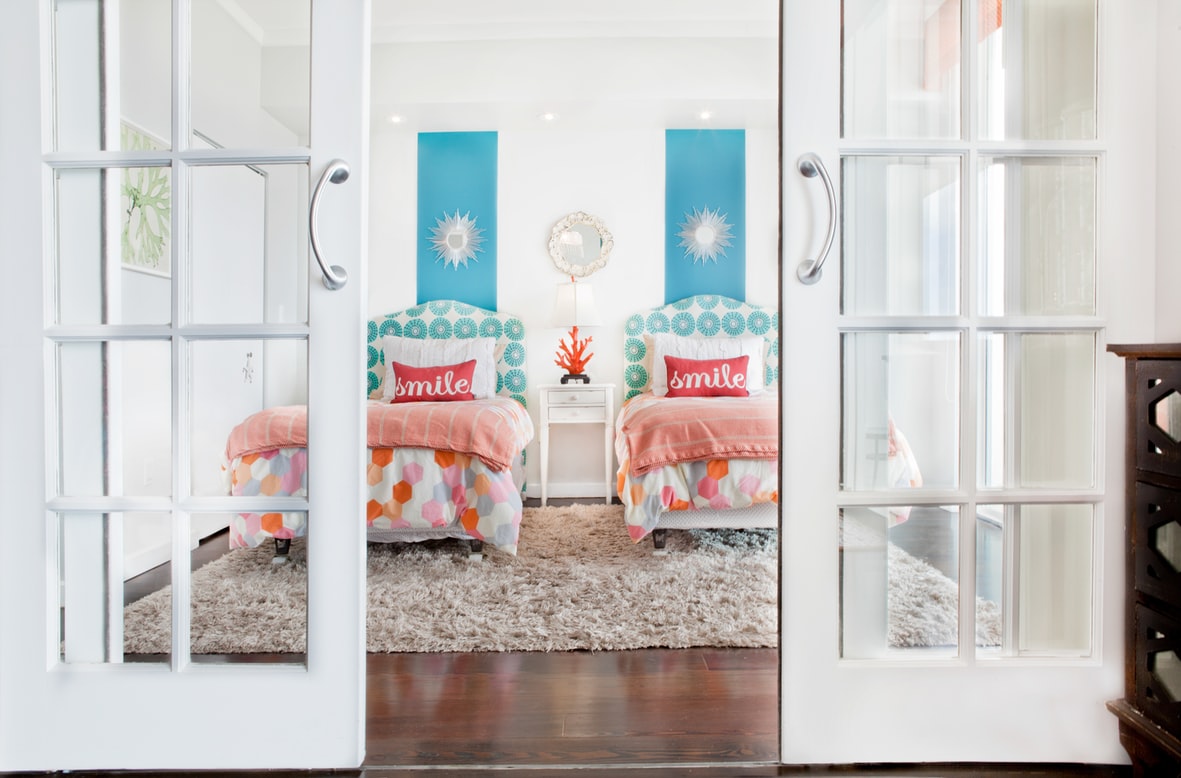
6. How to keep order? Some practical tips
One of the greatest difficulties that can be encountered in spaces intended for children is order, but to overcome the problem of misplaced toys, books on the floor and unfolded blankets, there are very useful practical solutions. To start with the walls that can be used as much as the furnishings, an interesting novelty is characterized by the padded panels that, once fixed to the wall, can be used to affix objects, posters and photographs.
Then there are the equipped walls, obtained thanks to modules that side by side in various ways, are ready to house toys, books and lamps. To help keep order more easily, classic coat hangers and shelves are also widely used which, in addition to ensuring the convenience of quickly choosing and wearing clothes and accessories, can be used to move bare walls.
As for the storage of toys, you can choose from a wide range of baskets and boxes with varied shapes and colors.
An excellent idea is to arrange objects and games according to the “bottom-up” scheme, placing the most used ones at child height and the least used ones in a higher position. In this way, the parent knows where everything is and the child is comfortable choosing what he wants at that precise moment. In the event that you have a small space, the drawers placed under the bed will be perfect, able to accommodate many games that will be within reach if necessary thanks to the comfortable wheels placed in the lower part. Wall organizers, bags with transparent boxes to identify the contents and toy-boxes are also well received.
Finally, the attitude that the parent has towards their children regarding order is of fundamental importance: if you get used to involving them from an early age in the organization of spaces, the children will feel responsible and will collaborate with pleasure, giving a big concrete contribution.

7. The internal pattern and the age group: characters closely linked together
When the interior design concerns the bedroom, it is necessary to take into account the age of the child, since more than for any other user, his needs change over time. It is therefore necessary to guarantee flexibility and be able to foresee sudden change since different tastes and needs correspond to each age. Following are some examples of interior design projects, divided according to age (neonatal and pre-school, school, adolescent) and gender.
0 – 36 MONTHS
During the first months, the baby’s room will be the place dedicated to the care of the little one; the furniture in addition to being of quality, in order to keep the environment healthy, must be functional above all to the mother who takes care of the baby. The most suitable tones for the walls are light blue, blue and pink and the same can be enriched with wallpaper decorations that show subjects belonging to the natural world and fairy tales. They are also reasons that can be easily removed over the years, making them perfect for the first stage of a child’s growth.
As far as the spatial organization is concerned, it must be conducted with a view to safety in order to avoid accidents and unforeseen events; in this case it is preferable to opt for capacious and functional furniture with soft and simple lines. The storage accessories and wall organizers are practical and useful for mothers when changing their baby, perfect to be placed near the changing table, they save time and space. Textile accessories, such as carpets, curtains and cushions must be safe and of quality; cotton, linen and natural fibers are preferable, while on the textures you can indulge in polka dots, clouds and stars.
Particular attention should be given to the lighting choices, since if during the day the environment is mostly illuminated by natural light, in the evening and at night, when the baby can be awake, it is necessary to use artificial light. Suspension lamps and wall lights are preferable which emanate a soft and non-violent light that can help sleep without bothering the newborn. Highly recommended are the luminaires characterized by perforated shells that reflect real patterns of light on the walls: relaxing and stimulating, they help the child to fall asleep.
Below is an example of the composition of the spaces dedicated to the baby and differentiated by gender.
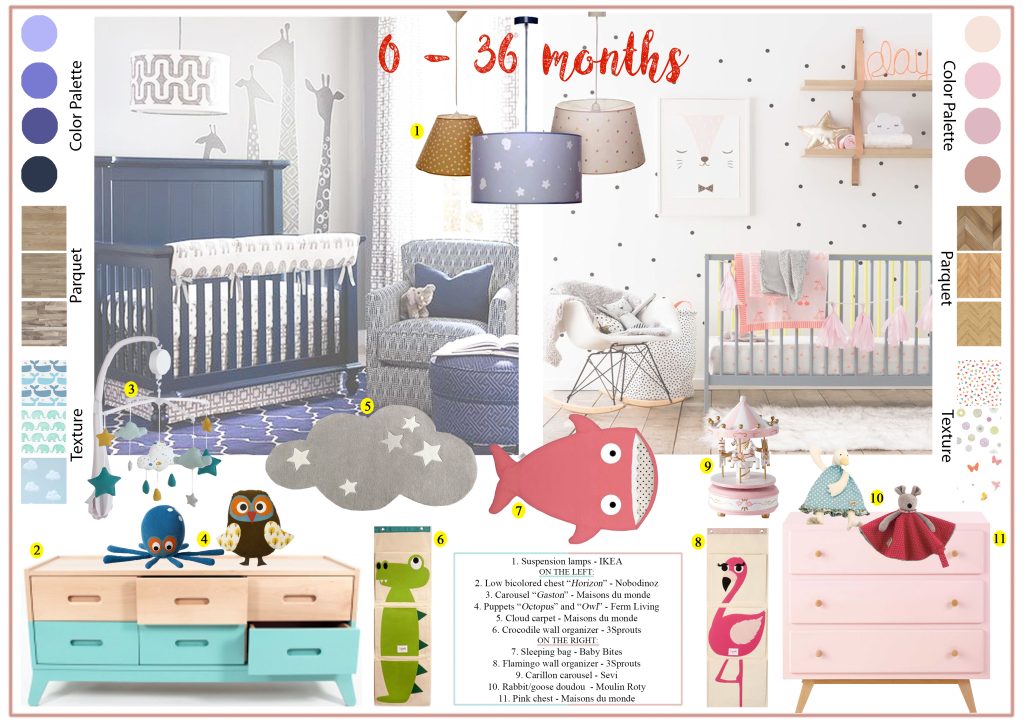
+ 3 YEARS
In this age group the child begins to interact with spaces and people, for this reason the goal is twofold: to find a solution that is safe for the child and that stimulates him enough. The idea of painting the ceiling or the wall on the head of the bed with a starry sky or the walls with cartoon characters may seem risky but if done with care it can give an excellent aesthetic result and efficient results to develop creativity and child’s fantasy.
Very suitable in this phase are the pastel colors of blue, light gray and pink, appreciated by the little ones, they rest the mind and ensure relaxation. In fact, it is of fundamental importance to remember that children must feel protected and safe and for this reason it will be optimal to decorate the walls and recreate “secret” and magical corners inside the bedroom with curtains and fabric houses.
From the furnishing point of view, there are many lines that meet the taste of parents and children: they range from ecological and totally wooden ones, to colorful ones with extravagant shapes, up to transformable and functional ones. Drawers and chests that contain clothes and objects, towable boxes used both as a game and as a container, height-adjustable stools, everything can be combined with taste even if not part of the same series.
In short, the watchword is to choose the furniture with imagination and according to needs with the aim of stimulating the imagination of young users by helping them to feel an integral part of their living spaces.
Starting from school age, it is essential to take into account the wishes of children who begin to develop their taste and first interests: decorations of dragons and characters from adventurous legends, badges of their favorite team, educational toys, everything must be studied for their needs. There are also some iconic figures in the growth of the child, which if inserted into the environment make him feel at ease. One of them is the classic house with a sloping roof; it can be purchased as a real game even if it is recommended only in the case of very large spaces. If the size of the room does not allow it, it will be perfect reproduced as a decoration on the wall or transformed into a small bookcase or container with a dual function.
The playful aspect together with the educational one must have priority over everything for the organization of the space that will be so functional and welcoming.
Below is an example of the composition of the spaces dedicated to school-age children and differentiated on the basis of sex.
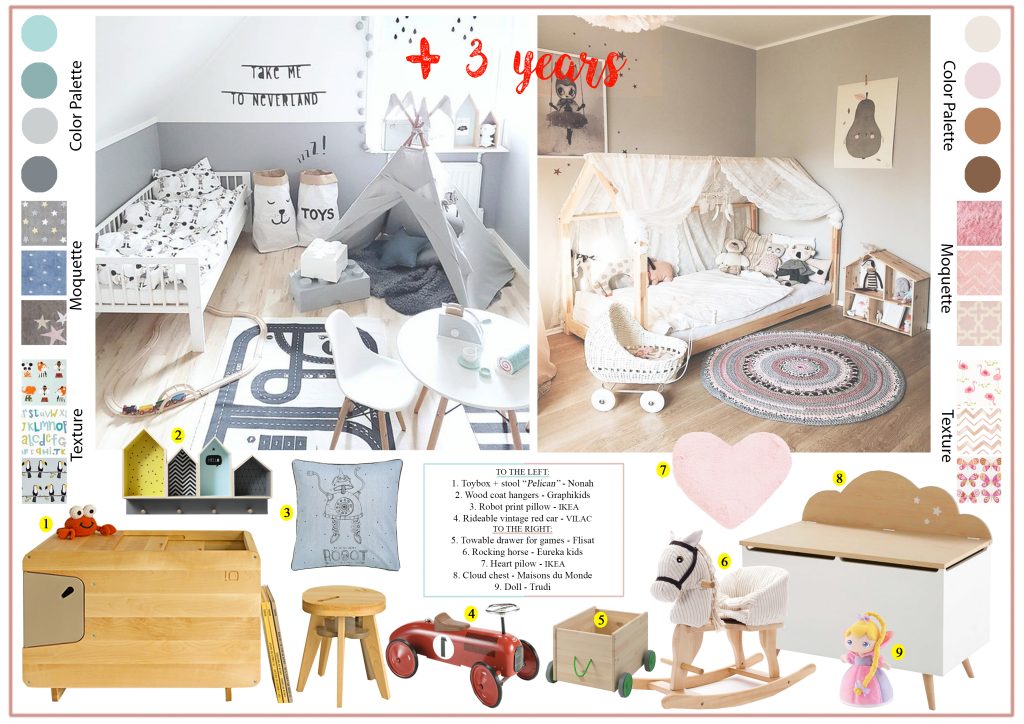
TEENAGER
If during childhood the attention is given to the playful aspect, with the passing of the years and with the growth of children, the needs change drastically. Toys make room for clothing and accessories for girls, while music and sports prevail over boys. The ideal would be to have plenty of space to tidy everything up in a comfortable walk-in closet, but contingencies do not always allow it. In the case of small or small spaces, you can opt for shelves and drawers that can contain accessories and clothes, the desk where you can study and the comfortable bed of adequate size. Usually the room is divided into a living area for study and leisure and a sleeping area.
From the point of view of decorations and accessories, parents must leave room for the choices of the children that will reflect the specific taste and personality. The freedom in the choice of colors and furnishings left to those who will live in the room is of fundamental importance, as well as expressing the personality of the children, it ensures the well-being of the same who will feel at ease. Alternatively, it is advisable to choose furniture with essential lines to allow teenagers to customize the spaces according to their style.
Below is an example of the composition of the spaces dedicated to the boy and differentiated by gender
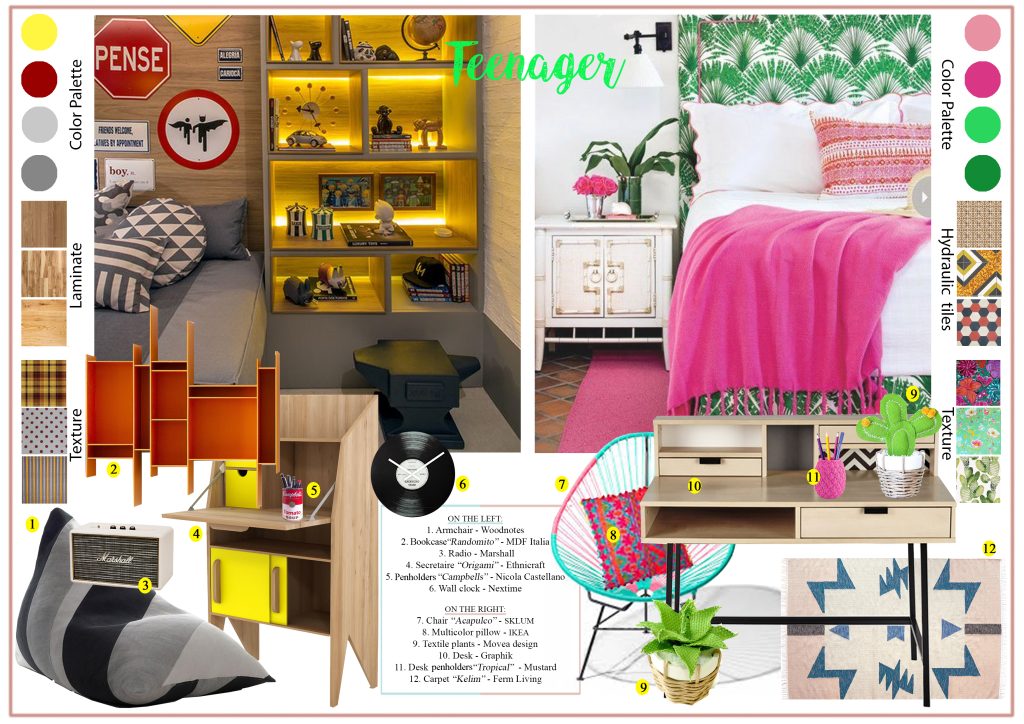
Tags
recommended cad blocks
DWG
DWG
DWG
DWG
DWG
DWG







































































